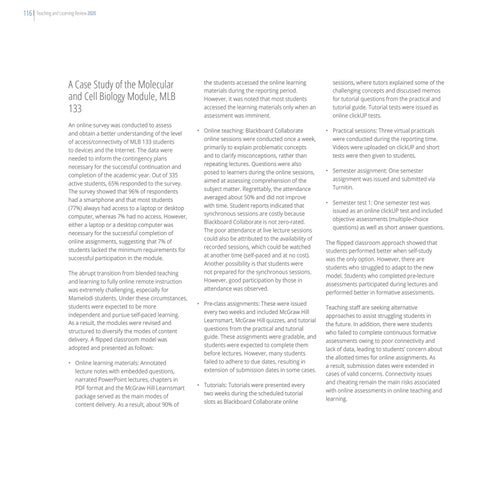116
Teaching and Learning Review 2020
A Case Study of the Molecular and Cell Biology Module, MLB 133 An online survey was conducted to assess and obtain a better understanding of the level of access/connectivity of MLB 133 students to devices and the Internet. The data were needed to inform the contingency plans necessary for the successful continuation and completion of the academic year. Out of 335 active students, 65% responded to the survey. The survey showed that 96% of respondents had a smartphone and that most students (77%) always had access to a laptop or desktop computer, whereas 7% had no access. However, either a laptop or a desktop computer was necessary for the successful completion of online assignments, suggesting that 7% of students lacked the minimum requirements for successful participation in the module. The abrupt transition from blended teaching and learning to fully online remote instruction was extremely challenging, especially for Mamelodi students. Under these circumstances, students were expected to be more independent and pursue self-paced learning. As a result, the modules were revised and structured to diversify the modes of content delivery. A flipped classroom model was adopted and presented as follows: • Online learning materials: Annotated lecture notes with embedded questions, narrated PowerPoint lectures, chapters in PDF format and the McGraw Hill Learnsmart package served as the main modes of content delivery. As a result, about 90% of
the students accessed the online learning materials during the reporting period. However, it was noted that most students accessed the learning materials only when an assessment was imminent. • Online teaching: Blackboard Collaborate online sessions were conducted once a week, primarily to explain problematic concepts and to clarify misconceptions, rather than repeating lectures. Questions were also posed to learners during the online sessions, aimed at assessing comprehension of the subject matter. Regrettably, the attendance averaged about 50% and did not improve with time. Student reports indicated that synchronous sessions are costly because Blackboard Collaborate is not zero-rated. The poor attendance at live lecture sessions could also be attributed to the availability of recorded sessions, which could be watched at another time (self-paced and at no cost). Another possibility is that students were not prepared for the synchronous sessions. However, good participation by those in attendance was observed. • Pre-class assignments: These were issued every two weeks and included McGraw Hill Learnsmart, McGraw Hill quizzes, and tutorial questions from the practical and tutorial guide. These assignments were gradable, and students were expected to complete them before lectures. However, many students failed to adhere to due dates, resulting in extension of submission dates in some cases. • Tutorials: Tutorials were presented every two weeks during the scheduled tutorial slots as Blackboard Collaborate online
sessions, where tutors explained some of the challenging concepts and discussed memos for tutorial questions from the practical and tutorial guide. Tutorial tests were issued as online clickUP tests. • Practical sessions: Three virtual practicals were conducted during the reporting time. Videos were uploaded on clickUP and short tests were then given to students. • Semester assignment: One semester assignment was issued and submitted via Turnitin. • Semester test 1: One semester test was issued as an online clickUP test and included objective assessments (multiple-choice questions) as well as short answer questions. The flipped classroom approach showed that students performed better when self-study was the only option. However, there are students who struggled to adapt to the new model. Students who completed pre-lecture assessments participated during lectures and performed better in formative assessments. Teaching staff are seeking alternative approaches to assist struggling students in the future. In addition, there were students who failed to complete continuous formative assessments owing to poor connectivity and lack of data, leading to students’ concern about the allotted times for online assignments. As a result, submission dates were extended in cases of valid concerns. Connectivity issues and cheating remain the main risks associated with online assessments in online teaching and learning.












































